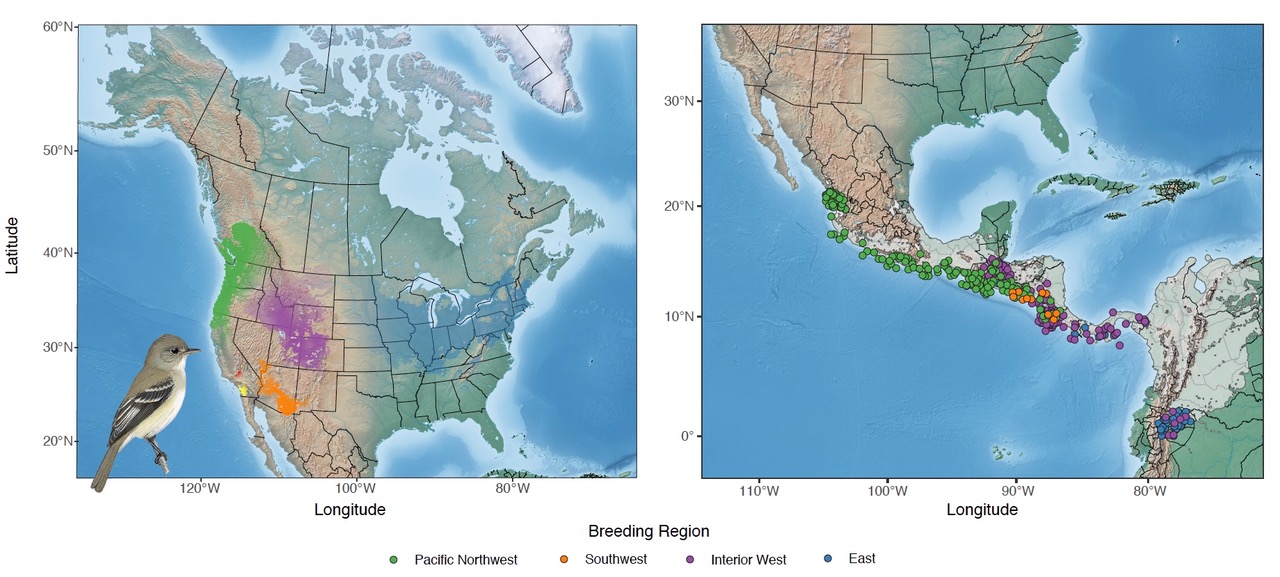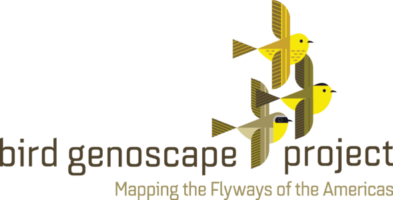Willow Flycatcher

Six of the seven genetically distinct populations of Willow Flycatcher (Empidonax traillii) (left map) across the breeding range: Pacific Northwest (green), Southwest (orange), Interior West (purple), East (blue), Kern California (red), and southern California (yellow). Individuals sampled on the wintering grounds (right map) were then assigned back to four of these genetic clusters, allowing us to better understand the migratory connectivity of Willow Flycatcher populations. Genetic clusters are visualized as transparency levels of different colors overlaid upon a base map from Natural Earth (naturalearthdata.com) and clipped to the species breeding range using an eBird shapefile. See below for details of samples used. Willow Flycatcher Image by © Birds of the World
The Willow Flycatcher (Empidonax traillii) is a habitat specialist that relies on wetlands with willows or other low-lying shrubs. While they are observed to be relatively common throughout their range, the Southwestern Willow Flycatcher (Empidonax traillii extimus) is a federally listed endangered species, suggesting that not all populations of this species are doing well.
The Bird Genoscape Project partnered with multiple collaborators (see below) to develop high-resolution molecular markers to identify breeding populations of Willow Flycatchers in North America. We scanned the genomes of 175 individuals from 37 sampling locations across the Willow Flycatcher breeding range to identify population genomic structure. In total, we’ve identified the existence of 7 genetically distinct populations of the Willow Flycatcher – Interior West (purple), Pacific Northwest (green), Eastern (blue), Southwest (orange), Kern, California (Red), southern California (yellow), and White Mountain, Arizona (not shown). These 7 populations can serve as the foundation for Willow Flycatcher conservation and management.
Additionally, former BGP postdoc Sheela Turbek sought to explore evolutionary responses to climate change in the endangered Southwestern Willow Flycatcher population using whole-genome comparisons between historical specimens, collected from 1888 to 1909 near San Diego, California, United States, and contemporary individuals from across the breeding range.
Bird Migration Explorer: Click here to see how Audubon’s Bird Migration Explorer has incorporated our Willow Flycatcher genoscape into their base map.
Publications:
Turbek SP, Bossu C, Rayne C, Gruppi C, Kus BE, Whitfield M, Smith TB, Paxton EH, Bay RA, and KC Ruegg. 2023. Historical DNA reveals climate adaptation in an endangered bird. Nature Climate Change 13: 735-741
Forester BR, Day CC, KC Ruegg, and EL Landguth. 2023. Evolutionary potential mitigates extinction risk under climate change in the endangered southwestern willow flycatcher. Journal of Heredity. 114: 341–353.
Ruegg KC, Anderson EC, Bay RA, Whitfield M, Paxton EH, and TB Smith. 2021. Linking climate niches across seasons to assess population vulnerability in a migratory bird. Global Change Biology 27: 3519-3531
Ruegg K, Bay RA, Anderson EC, Saracco JF, Harrigan RJ, Whitfield M, Paxton EH, and TB Smith. 2018. Ecological genomics predicts climate vulnerability in an endangered southwestern songbird. Ecology Letters 21: 1085-1096
Access to Sequencing Data:
Team:
Eric C. Anderson, Southwest Fisheries Science Center
Marius Someveille, Colorado State University
Rachel A. Bay, UC Davis
Mary Whitfield, Southern Sierra Research Station
Eben H. Paxton, US Geological Survey Pacific Island Ecosystems Research Center
T. Kita
B. Kus
R. Taylor
M. Fylling
M. Sogge
T. Koronkiewicz
B. Keith
Vincent J. Coates Genomics Sequencing Laboratory
MAPs station operators within the Institute of Bird Populations Network
Utilized Willow Flycatcher Samples
Explore the map below to see when, where, and who collected the samples to build this genoscape.
